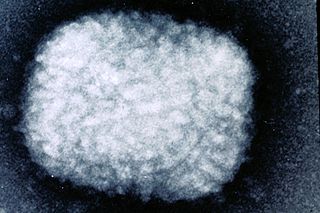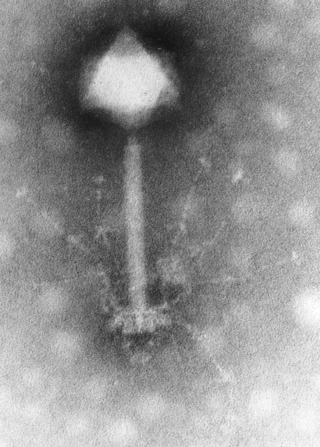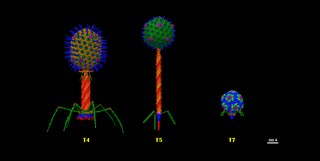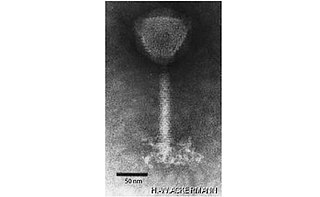
Family is one of the nine major hierarchical taxonomic ranks in Linnaean taxonomy. It is classified between order and genus. A family may be divided into subfamilies, which are intermediate ranks between the ranks of family and genus. The official family names are Latin in origin; however, popular names are often used: for example, walnut trees and hickory trees belong to the family Juglandaceae, but that family is commonly referred to as the "walnut family".

Parvoviruses are a family of animal viruses that constitute the family Parvoviridae. They have linear, single-stranded DNA (ssDNA) genomes that typically contain two genes encoding for a replication initiator protein, called NS1, and the protein the viral capsid is made of. The coding portion of the genome is flanked by telomeres at each end that form into hairpin loops that are important during replication. Parvovirus virions are small compared to most viruses, at 23–28 nanometers in diameter, and contain the genome enclosed in an icosahedral capsid that has a rugged surface.

Sedoreoviridae is a family of double-stranded RNA viruses. Member viruses have a wide host range, including vertebrates, invertebrates, plants, protists and fungi. They lack lipid envelopes and package their segmented genome within multi-layered capsids. Lack of a lipid envelope has allowed three-dimensional structures of these large complex viruses to be obtained, revealing a structural and likely evolutionary relationship to the cystovirus family of bacteriophage. There are currently 97 species in this family, divided among 15 genera in two subfamilies. Reoviruses can affect the gastrointestinal system and respiratory tract. The name "reo-" is an acronym for "respiratory enteric orphan" viruses. The term "orphan virus" refers to the fact that some of these viruses have been observed not associated with any known disease. Even though viruses in the family Reoviridae have more recently been identified with various diseases, the original name is still used.

Poxviridae is a family of double-stranded DNA viruses. Vertebrates and arthropods serve as natural hosts. There are currently 83 species in this family, divided among 22 genera, which are divided into two subfamilies. Diseases associated with this family include smallpox.

Myoviridae was a family of bacteriophages in the order Caudovirales. The family Myoviridae and order Caudovirales have now been abolished, with the term myovirus now used to refer to the morphology of viruses in this former family. Bacteria and archaea serve as natural hosts. There were 625 species in this family, assigned to eight subfamilies and 217 genera.

Podoviridae was a family of bacteriophage in the order Caudovirales often associated with T-7 like phages. The family and order Caudoviraleshave now been abolished, with the term podovirus now used to refer to the morphology of viruses in this former family. There were 130 species in this family, assigned to 3 subfamilies and 52 genera. This family was characterized by having very short, noncontractile tails. Many former phages in the former family Podoviriade are now classified in the Autographiviridae

Tombusviridae is a family of single-stranded positive sense RNA plant viruses. There are three subfamilies, 17 genera, and 95 species in this family. The name is derived from Tomato bushy stunt virus (TBSV).

Caudoviricetes is a class of viruses known as the tailed bacteriophages. Under the Baltimore classification scheme, the Caudoviricetes are group I viruses as they have double stranded DNA (dsDNA) genomes, which can be anywhere from 18,000 base pairs to 500,000 base pairs in length. The virus particles have a distinct shape; each virion has an icosahedral head that contains the viral genome, and is attached to a flexible tail by a connector protein. The order encompasses a wide range of viruses, many containing genes of similar nucleotide sequence and function. However, some tailed bacteriophage genomes can vary quite significantly in nucleotide sequence, even among the same genus. Due to their characteristic structure and possession of potentially homologous genes, it is believed these bacteriophages possess a common origin.

The International Committee on Taxonomy of Viruses (ICTV) authorizes and organizes the taxonomic classification of and the nomenclature for viruses. The ICTV develops a universal taxonomic scheme for viruses, and thus has the means to appropriately describe, name, and classify every virus taxon. The members of the International Committee on Taxonomy of Viruses are considered expert virologists. The ICTV was formed from and is governed by the Virology Division of the International Union of Microbiological Societies. Detailed work, such as identifying new taxa and delimiting the boundaries of species, genera, families, etc. typically is performed by study groups of experts in the families.

Gammaherpesvirinae is a subfamily of viruses in the order Herpesvirales and in the family Herpesviridae. Viruses in Gammaherpesvirinae are distinguished by reproducing at a more variable rate than other subfamilies of Herpesviridae. Mammals serve as natural hosts. There are 43 species in this subfamily, divided among 7 genera with three species unassigned to a genus. Diseases associated with this subfamily include: HHV-4: infectious mononucleosis. HHV-8: Kaposi's sarcoma.

Betaherpesvirinae is a subfamily of viruses in the order Herpesvirales and in the family Herpesviridae. Mammals serve as natural hosts. There are 26 species in this subfamily, divided among 5 genera. Diseases associated with this subfamily include: human cytomegalovirus (HHV-5): congenital CMV infection; HHV-6: 'sixth disease' ; HHV-7: symptoms analogous to the 'sixth disease'.

The Herpesvirales is an order of dsDNA viruses with animal hosts, characterised by a common morphology consisting of an icosahedral capsid enclosed in a glycoprotein-containing lipid envelope. Common infections in humans caused by members of this order include cold sores, genital herpes, chickenpox, shingles, and glandular fever. Herpesvirales is the sole order in the class Herviviricetes, which is the sole class in the phylum Peploviricota.

Secoviridae is a family of viruses in the order Picornavirales. Plants serve as natural hosts. There are 8 genera and 86 species in this family, one of which is unassigned to a genus. The family was created in 2009 with the grouping of families Sequiviridae, now dissolved, and Comoviridae, now subfamily Comovirinae, along with the then unassigned genera Cheravirus, Sadwavirus, and Torradovirus.

Autographiviridae is a family of viruses in the order Caudovirales. Bacteria serve as natural hosts. There are 373 species in this family, assigned to 9 subfamilies and 133 genera.
Picovirinae is a subfamily of viruses in the order Caudovirales, in the family Salasmaviridae. Bacteria serve as natural hosts. There are two genera and seven species in this subfamily.
Spbetavirus is a genus of viruses in the order Caudovirales, in the family Siphoviridae. Bacteria serve as natural hosts. There is only one species in this genus: Bacillus virus SPbeta.
Tristromaviridae is a family of viruses. Archaea of the genera Thermoproteus and Pyrobaculum serve as natural hosts. Tristromaviridae is the sole family in the order Primavirales. There are two genera and three species in the family.

Nyamiviridae is a family of negative-strand RNA viruses in the order Mononegavirales. Ecdysozoa and birds serve as natural hosts. The name is a portmanteau of Nyamanini Pan and Midway Atoll and the suffix -viridae used to denote a virus family. There are seven genera in this family.
Eucampyvirinae is a subfamily of viruses in the order Caudovirales, in the family Myoviridae. Bacteria of the genus Campylobacter serve as natural hosts. There are 9 species in this subfamily, assigned to 2 genera.

Herelleviridae is a family of bacterial viruses of the order Caudovirales infecting members of the phylum Firmicutes. The family has five subfamilies, 33 genera and 92 species.















